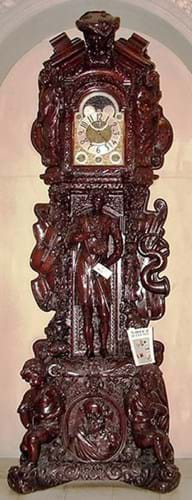
Although spuriously signed on the dial Joshua Hampson fecit 1743, the monumental 12ft (3.66m) high and 4ft 2in (1.27m) wide longcase was profusely carved with three-dimensional figures from the Dick Whittington tale.
It not only included Whittington chimes but played seven related tunes.
The so-called Whittington chime, popular in English clocks from the Victorian period onwards, takes its name from a much earlier folk tale.
As the story goes, the young Dick Whittington, a poor orphan from the West of England (he was born in Pauntley near Newent sometime in the middle of the 14th century), had tired of life working in the household of a rich Leadenhall Street merchant Mr Fitzwarren.
He stole away early in the morning of All Hallows Day, and left the City behind him, but as he rested at Highgate he heard Bow bells ring out a merry peal. The distinctive chime seemed to say: Turn again, Whittington, Thrice Lord Mayor of London.
Dick returned to Fitzwarren to learn that the cat he had reluctantly sent on a voyage in his master's ship had been sold for a great fortune to the King of Barbary, whose palace had been overrun with mice. Dick had become a rich man and would subsequently become Fitzwarren's son-in-law. As the bells said, he served as Lord Mayor of London on three separate occasions: first in 1397, then again in 1406-7, and for the third and final time in 1419-20.
The cat, the mice, Father Time, Lady Justice and Mr Fitzwarren are all here on the longcase alongside the words Turn again Whittington Thrice Lord Mayor of London. The central figure of Whittington is not far short of lifesize.
There are a number of similar clocks in US collections, acquired by American industrialists from British firms who displayed their most flamboyant wares at the international exhibitions.
This example was probably owned by the Elkins family (a powerful name in Pennsylvania society) and resided at the former Elkins family mansion, designed by well-known Philadelphia architect Horace Trumbauer. It was, understandably, left in situ when the house and gardens were bought by the congregation of Dominican Sisters of St Catherine de' Ricci in 1932 to be used as a place for conducting weekend retreats for women.
Alderfers held a two-day sale at the property on April 22-23 where the clock sold to the new owner of the property at $310,000 (£168,000) (plus 10% buyer's premium).
The auctioneers, who had predicted that the clock might bring $40,000-60,000, said it was the largest and highest-priced piece of furniture they had ever sold.




